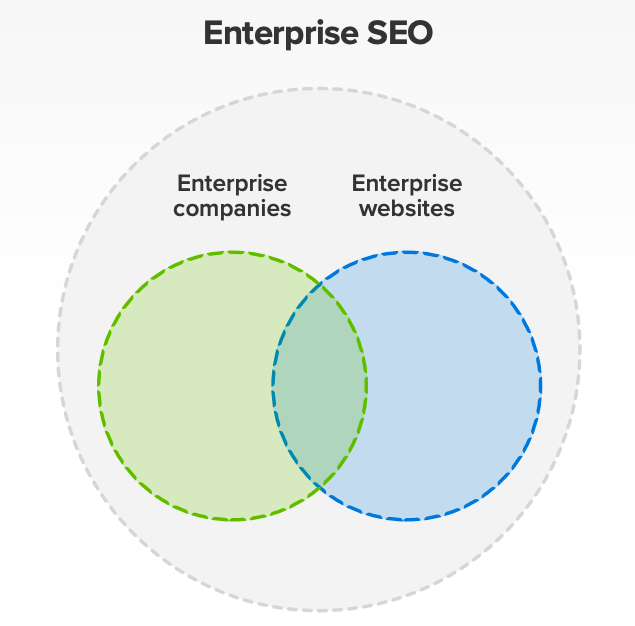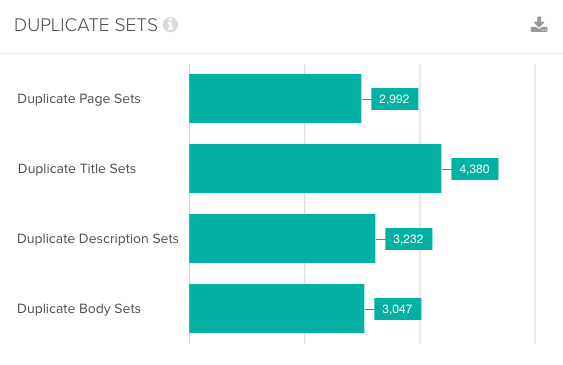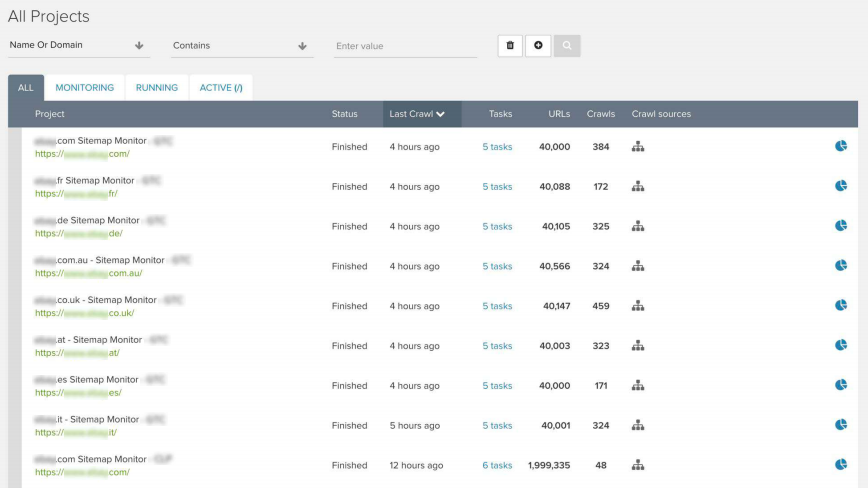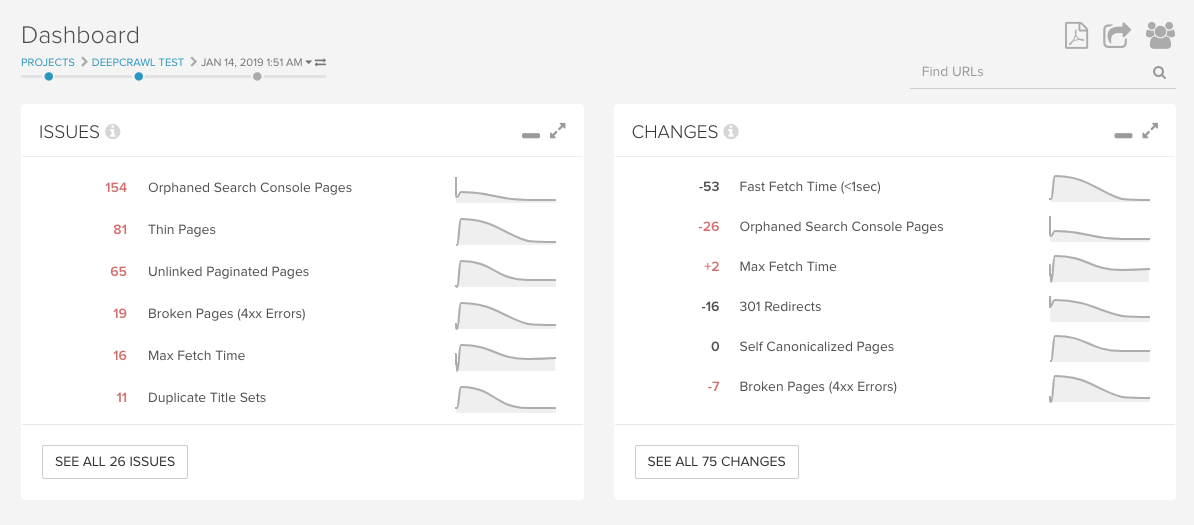What is enterprise SEO?
To be able to understand how to succeed in enterprise SEO, we first need to define what it means. This is more challenging than you might initially expect, as many of the existing guides on this topic either refer to enterprise SEO as dealing with large corporate organizations or managing large websites.
It is hard to define enterprise SEO as it can refer to the implementation of SEO within large corporate organizations, or the management of large websites.
We sent out a poll for the industry to try and clear things up, here are the results:
❓ Hey #SEO community, we have a question for you!
When you define Enterprise SEO, what is the key characteristic of ‘enterprise’?
—Lumar (@Lumar) May 29, 2019
It’s interesting to see that, according to the majority of responses to our poll, the size of the organization and the size of the website are often correlated in enterprise SEO. This makes sense because huge, international brands may need enormous websites to accommodate all of their different service offerings across the globe.
Take a look at eBay as an example:

However, you’ll still get gargantuan brands that have small websites spanning a couple of hundred or a few thousand pages. The scale of a website will always depend on the organisation’s business needs.

Perhaps we can consider enterprise SEO as an umbrella term which is comprised of enterprise companies and enterprise websites, which have some natural overlap between them.

Other aspects that can feed into the definition of enterprise SEO is the scale of traffic. For example, you might refer to a website that receives millions of visits each month as an enterprise site. Also, the amount of people involved in approving SEO actions and activity can be a factor when classifying a business as an enterprise.
Other: The size of the decision-making chain
— Chung Fei Wu (@ChungFeiWu) May 29, 2019
No matter how you define it, the common theme within enterprise SEO is scale. Whether that’s the scale of the brand, the scale of the website, or the scale of traffic. In this guide we want to accommodate for these varying interpretations, so we will aim to address both the challenges of working as an SEO in a large organisation, as well as the challenges of managing large websites.
The biggest challenges of managing enterprise sites
Working on enterprise websites comes with its own set of unique challenges. In this section of our guide, we’ll explain what the main difficulties are that you need to watch out for when managing websites.
Here are some of the key challenges for enterprise websites to be aware of:
- Corporate environments
- Website scale
- Legacy issues
- Crawlability & indexability
- Content quality
- Identifying issues
Corporate environments
In enterprise organisations, SEO can be overlooked due to tough competition between numerous departments all vying for resource.
Enterprise companies usually have large, complex organisational structures spanning many different departments across many different countries. This means that there will be multiple teams with different goals and KPIs, all competing for buy-in. Sadly, the fight for resource is where SEO can often be overlooked.
Enterprise businesses are for-profit, meaning that their overarching purpose is to drive revenue. However, it is notoriously difficult to show the return on investment (ROI) of SEO, so it can be a huge challenge to prove the value of the channel within a company that is focused on making money.
As a result, it can be a long and difficult process to get SEO recommendations added into the development pipeline in the first place, let alone moved along in the queue with all of the other priority items from all of the other teams.
Enterprise SEOs therefore need to be able to navigate internal politics, effectively communicate with stakeholders and be persuasive enough to get buy-in for SEO activities. You need to know who is making decisions around roadmap prioritisation, and you also need to know how to collect data that tells a compelling story to grab the attention of stakeholders and decision-makers.
Website scale
Any challenges you face with your website are proportional to its scale. So the bigger the site, the bigger the problem, and getting SEO right is difficult enough for smaller sites.
Enterprise SEO maintains the fundamentals of SEO such as optimising content, links and metadata, but it has the added complexity of scale. Whereas in a smaller company you might have access to make necessary changes on a page-by-page basis, on an enterprise site you will likely need to get the necessary approval to make any changes in the first place, and also find a way of rolling out changes to thousands, or even millions of pages.
Whether you’re working with a small website or an international enterprise, the fundamentals of SEO don’t change much. What does change is the scale. Managing a website of a few hundred pages is very different from managing a site with thousands of pages. It’s not uncommon to invest resources in generating new content to target a specific group of high-value keywords, when there are existing URLs which could be re-purposed or optimised.
Attention to detail and prioritisation are critical in identifying where your efforts should be spent. Always ask yourself the question “which sections of the site drive the most value for the business?” Data-driven insights should be at the heart of your decision-making.

Website scale can refer to either the size of one website, or the number of domains under the main company umbrella. For example, Johnson & Johnson is an enterprise company with a large number of smaller subsidiaries with their own websites.

Whether you’re dealing with one huge website or a lot of smaller websites, you’ll have considerably large datasets on your hands which require certain skills to be able to work with them. Relying on Excel which has a 1 million row limit to analyse data for a site with significantly more URLs than that just won’t cut it.
This means that you’ll need more powerful solutions for handling this amount of data, as well as efficient processes for collecting and analysing it as quickly as possible. We’ll discuss some methods for doing this later on in this guide.
Legacy issues
Enterprise SEO success is often limited by legacy tech stacks which can cause both page load speed issues and onsite implementation issues.
Enterprise SEOs are often faced with the challenge of having to work with complex legacy tech stacks and unwieldy websites with years’ worth of platform alterations, code additions and URL restructuring. This is an issue from a day-to-day maintenance perspective, but this can also bloat pages for the end-user and make them slow to load.
All of this is to be expected in an enterprise business, with countless employees coming and going over the years across multiple departments, and implementing different technical strategies. In an ideal world, everything that is created within a website will be maintainable in the long run, however, it is a very rare scenario where the SEO who manages an enterprise site has been there to guide and steer the website setup from the start.
Legacy issues and poor technical foundations can really impact an SEO’s efforts to do their job and ‘move the needle’ in terms of performance, so it’s important to review your CMS and tech stack so you are fully aware of their limitations before you put all of your resources into SEO campaigns which could be doomed to fail.
To set yourself up for success, try and ensure the following wherever possible:
- Consistency of technologies and platforms across the websites you manage for easier implementation of SEO fixes.
- Make sure the CMS has the capability to add and edit key SEO elements, including canonical tags, noindex meta tags, title tags, internal links, structured data and sitemaps.
- Check that the database has clean data, including correct categorisation and population of necessary descriptive fields.
Crawlability & indexability
Enterprise SEOs need to take more control over search engine crawling, as large sites can be difficult for search engines to process unless crawl budget is managed correctly.
For a website’s important pages to be indexed and shown in the search engines’ results pages, these pages have to be crawlable. Unfortunately, this can be a significant problem for enterprise sites that have millions of pages that need to be sifted through to be able to find crucial pages.
The crawlability of a website depends on a number of different factors, including:
- Crawl errors
- URL duplication
- Internal linking
- Redirects
- Canonical tags
- Server response time
Pages with long download times can reduce Googlebot’s crawl budget.
-John Mueller, Google Webmaster Hangout
It can be more harmful than you might think if Google and the other search engines are left to crawl as many URLs as they can find without proper restrictions in place. Not only does excessive crawling add to the business’ server cost, but also if search engines find and crawl too many low quality or auto-generated URLs, they could completely miss the new, valuable content on your site that you want to have indexed.
URL duplication is an issue on larger sites as Google is more likely to miss new content.
-John Mueller, Google Webmaster Hangout
The key to encouraging search engines to crawl more of a site’s important pages is to increase the visibility and importance of these pages on the site through internal linking, and restrict their access to low quality pages that provide no value for the business.
Content quality
The scale of enterprise websites means that content quality analysis can be neglected, and pages with duplicate or thin content can go unnoticed. This can cause problems for both users navigating the website as well as the search engines trying to crawl and index it.
Duplicate content can get out of hand very quickly on an enterprise website which has elements like complex faceted navigation and internal search pages which auto-generate thousands of new URLs which have no unique or valuable content.

Source: Lumar
This can make it much more difficult for search engines to be able to crawl a website and find relevant content to add to its index.
Duplicate content makes large sites harder to crawl.
-John Mueller, Google Webmaster Hangout
It can also make it more likely that Google will completely miss seeing new content, which can be a significant issue.
URL duplication is more of an issue on larger sites as Google is more likely to miss new content.
-John Mueller, Google Webmaster Hangout
Duplicate or thin content can go unnoticed on enterprise sites due to their size and the number of URLs they produce, and this can cause longer-term issues in terms of performance.
Writing out unique, descriptive content for every single page on an enterprise site would take a tremendous amount of time and resources. Instead, you need to focus on improving the content on pages that add value to your business, and prevent the ones that don’t from being accessible to users or search engines.
Pages that will be worth prioritizing and investing time into for improving content include:
- Pages receiving a lot of traffic.
- Pages that are crucial to the current conversion journeys across your site.
- Pages receiving a lot of impressions in organic search.
- Pages covering topics that are valuable to your business and have a realistic opportunity of ranking for them.
Not every page with thin content on a website can be improved, and there are solutions out there for handling pages that provide no value, such as redirecting them to a relevant page or noindexing them.
Identifying issues
When managing either an enormous site or a multitude of smaller sites, it can be difficult to be able to easily spot issues at a glance. This process can often take up a significant amount of time unless you have set up an efficient, streamlined approach to be able to drown out the noise of large datasets and highlight problem areas.
In enterprise SEO, it’s crucial to be able to maintain a top-level view of performance and technical health for a large portfolio of URLs or domains, to be able to detect issues before they arise. Being able to mitigate errors on a site before they become problematic enough to start affecting the bottom line will save the business both time and money in the long run.
Here are just a few examples of some of the key elements that need to be monitored on an ongoing basis:
- Increases in non-indexable pages
- Increases in server errors
- Increases in broken links
- Increases in pages with high fetch times
- Increases in pages with duplicate content
If any of these elements start to fluctuate significantly, this can act as an alert to a significant technical issue that could impact performance if left unfixed.
Maintaining a top-level view of key issues on an ongoing basis through website monitoring is essential for staying on top of the technical health of enterprise sites.
Website crawling tools are incredibly useful for ongoing site monitoring across a number of different websites, especially when you schedule regular crawls which will allow you to see positive or negative changes between crawls at a glance.

Source: Lumar

Source: Lumar
Try out Lumar’s monitoring capabilities for yourself
Now that we’ve outlined some of the main pitfalls in enterprise SEO that can impede performance, let’s explore some of the areas which can help you achieve success for the websites you manage in the remaining chapters of this guide.
Working on enterprise SEO doesn’t always mean you have a big SEO team! In my experience you can still achieve a lot with a small team by being strategic with your SEO projects and asks. Here are my top 13 tips to supercharge your enterprise SEO:
- Understand the Technology Used: Providing SEO recommendations that can’t be implemented due to limitations in technology will make it harder for you to get buy-in on future asks. Understand your CMS, frontend, tech stack, etc. so when you provide recommendations you will have answers on how to implement them.
- Build Relationships: Having great connections with the major stakeholders in your company can help you push your asks up the queue. There’s nothing more frustrating than having almost all your SEO asks in the backlog waiting for resources. Make sure you have great connections within the tech team.
- Quick Wins First: No one wants to work on huge projects that take forever if they are not sure about the outcome. You need to build trust by getting the SEO low hanging fruit (low effort, high impact) first, and show great results. This way you gain the trust of other teams, then you can ask for your bigger projects.
- Development/Engineering Teams – Greatest Ally or Worst Nightmare: Make sure you train the engineering teams on SEO and the importance of having SEO-friendly implementation. You also need to develop an appreciation for their work and understand their production cycle.
- Align your Goals with the Company’s: Yes, you have many SEO projects that need support, but find the ones that align with the company’s goals and show how these goals can be achieved by integrating SEO into the project.
- Find Hidden Resources: You need to understand your organization well to find available resources that can help you with SEO projects that you don’t have the bandwidth for. For example, the PR team can help a little with outreach and link building.
- Develop Analytical Skills: It is extremely important to show the results of your work to get more resources and funding. Waiting for other teams to analyze the data for you can take forever. Sharpen your Excel/Google Sheets, SQL and Google Data Studio skills, you will definitely need it.
- Show Value & Communicate Results: You need to promote your work within the company via data and story-telling. You can create an SEO newsletter or get invited to other team meetings where you share the results of the SEO projects they worked on. Know your audience and make sure you share stories they care about in a language they understand.
- Choose Your Battles Wisely: Not every SEO recommendation is worth fighting for. Can’t get your H2s in places and the semantic layout is broken, so what. Fight for the ones that will make a huge difference, not the nice-to-haves.
- Providing Keywords is Not Your Main Job: Don’t get me wrong, it is important, but if this is all what other teams are asking from you then something is wrong. You are their “strategic partner”. Understand their goals and success metrics and deliver strategic recommendations that will help their projects to succeed in terms of search.
- Ongoing Training & Refreshers: Don’t get frustrated if the editorial team forgot to implement what you taught them in your SEO training. Their main goal is to produce quality, accurate content and they have so many other fighting priorities. Train and train again and show results until SEO becomes top of mind or second nature.
- Integrate SEO into the Product Cycle: Work with your product managers and make sure SEO is integrated into the product cycle (kick off, content recommendations, design recommendations, technical recommendations, and most importantly QA). Define what are the important touchpoints so SEO is not just an afterthought.
- Make Them the Hero: Communicate results of your SEO projects to participating teams. Make a big deal of giving public acknowledgement of their vital contribution. Highlight their hard work and emphasize how SEO helped with the project success. When you focus on making other teams successful, you’ll earn their trust and they will be looking for the next opportunity to work with you.

Chapter 2: Building a Culture of SEO in Enterprise Organisation

